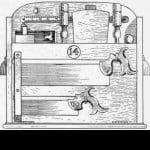Planing Technique
- This topic has 4 replies, 4 voices, and was last updated 11 years ago by
 Scott.
Scott.
-
AuthorPosts
-

This is not a post to discuss bench height, but planing.
Paul refers to bulldogging plane, but have not seen a complete description of this. In http://paulsellers.com/2013/07/ouch-blistering-plane-workout/ Paul says
Unfortunately, plane users on the sides of carpentry vans, most magazine articles and most if not all schools, public and private show a fistlike grip on the bench planes with knobs as you describe. ‘Bulldogging’ the plane to task is also a popular and misleading projection and people think that this is normalcy for woodworkers.
In a resent blog Christopher Schwarz states that he needs to put his weight on the plane to not get his arms tired.
Now I’m just a hobbyist and probably just plane for a couple of hours at a time, I don’t put much down force on the plane, just letting the blade dig into the wood and pull itself down. But my arms don’t get tired either.
What i’m trying to hear from you is if there is a better technique or is it all just up to personal preference?
Johan,
My planing Improved as soon as I stopped putting a lot of downward pressure on the plane. After a while you find what works for you, and develop your own technique.On longer boards I seem to use my legs more than my arms, I now think of going forward, and try and stop thinking of pushing down. Everyone in the woodworking teaching world will tell you something different, try them all, then find your own style. 😉
 24 July 2013 at 3:59 pm #15219
24 July 2013 at 3:59 pm #15219When I first started, I used a lot of downward pressure, being guilty of “bulldogging” myself. As I have progressed a bit in my skills with fettling and handling the plane, I find that in general somewhat less pressure is needed. The amount of grip pressure I need on the front knob now is definitely less than what I used at first.
I think *some* amount of downward pressure is important and necessary; I would like to think that there was a good reason for the development and popularity of the heavier infill planes and the bedrock models.
I don’t think that the equation is as simple as heavier=better, however. I think the downward pressure required incorporates more variables including the hardness of the wood, the grain character, knots in the wood, sharpness and set-up of the plane and the depth of cut desired.
I also think this is one of those things that is at least partly learned through experience, and doing; it was certainly that way for me. The more I work wood, the more refined my skills become and the more comfortable I get in using them. While Paul’s videos have been a revelation and have taught me a great deal, there is only so much that translates through that medium, and skills must be developed through practice and trial and error. A video can show me how to do something, but it can’t convey how it *feels* to do it.
As Ken said, work with different methods, *feel* how they all work for you and decide what is best for yourself.

I have recently been spending some time planing some 13.5″ wide cherry panels for Paul’s toolbox project. This is the first time for me planing boards that wide. Not my favorite task, but I am getting better. I’ve been using my low angle jack and an ECE smoother so far. The LA Jack feels heavy and cumbersome at times, but does a good job when the iron is ground at a higher angle. Stopping to wax the cast iron sole was at first tedious, but now is becoming second nature. The ECE plane glides across the wood as is, and is reserved for light finishing passes, so for me it is always a pleasure. I’ve even been able to use both planes left or right handed without too much difficulty…which keeps me from having to rotate the board as much.
I think what really conserves my energy is working smartly/efficiently. At first my passes were way too light, so getting to flat and to thickness was taking way too long. Now I know to take deeper cuts to approximate my goal, then switching to lighter passes with the jack and then the smoother. I may start employing an old No. 5 that I have for the rougher work so I do not have to keep adjusting the planes as I work.
As far as bulldogging is concerned, I am having better results keeping the downward pressure steady but as relaxed as I can. Too much pressure downward can probably flex the plane (as Paul says) or even the board being planed, which probably cannot end well. Didn’t Paul state that the act of taking a shaving pulls the plane to the wood as the iron naturally wants to dive?
I’ve noticed that Paul’s various grips on the planes he uses are all fairly delicate and relaxed. Sometimes he has just his thumb and forefinger on the knob and the rest on the bed of the plane. Sometimes his grip appears slightly firmer, usually cupping the knob with his thumb, forefinger and ring finger.

[quote quote=15219]I think *some* amount of downward pressure is important and necessary; I would like to think that there was a good reason for the development and popularity of the heavier infill planes and the bedrock models.[/quote]
Chris-
I have read that mass is also helpful for powering _through_ the cut, keeping an even momentum across the board. By contrast, my light wooden smoother will tend to stop/start/stop/start more if I do not maintain a steady forward motion. For me this lack of mass is only a problem for more aggressive passes, which is not the usual task of a smoother.
-
AuthorPosts
- You must be logged in to reply to this topic.
